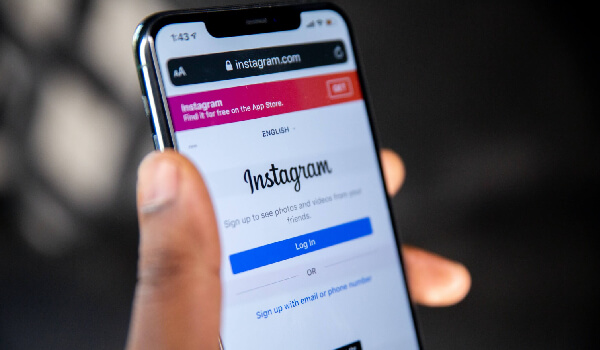The number of brands incorporating Instagram marketing into their business strategy has surged in recent years. While just over half of U.S. marketers used Instagram in 2016, more than 75% will do so by 2020.
It’s no wonder: Instagram has a billion monthly active users, and an advertising audience of more than 849 million.
This Instagram marketing tips for 2020 cheat sheet will help rev up your Instagram strategy, whether you’re just getting started or you’re already a seasoned pro.
Setting up an Instagram for business account
Before you get started with Instagram marketing, you need an Instagram for Business account or an Instagram Creator account. If you already have one, skip ahead to the tips below. If you already have a personal account, you can skip to step no. 3 of these instructions.
If you’re brand new or are creating a brand new account, here’s what to do:
Step 1: Download the Instagram app
Step 2: Sign up
- Open the app.
- Tap Create New Account (on iOS) or Sign Up With Email or Phone Number (on Android).
- Enter your email or phone number.
- Create your username and password.
- Fill out your profile info (more on this in Tip 4) and tap Done.
Step 3: Switch to a business account
- Go to your profile and tap the hamburger icon at the top right.
- Tap Settings, then Account.
- Connect your account to your Facebook business page, if you have one.
- Add your business details.
- Tap Done.
17 Instagram marketing tips you can’t afford to ignore
1. Use a business account
Just in case you skipped over the section above and plan to dive into the rest of the tips while using a personal account, here’s why you should reconsider.
A business account gives you access to features you can’t use with a personal account, including:
- Instagram Insights (see Tip 17)
- Instagram ads (see Tip 16)
- Instagram Shopping (see Tip 13)
- Contact information and a call-to-action button on your profile
A creator account has its own set of benefits for influencers and content creators. But for most marketers, a business account is where it’s at. Hop back up to the top of this post and convert your account if you haven’t already done so.
2. Clearly define your goals
All social platforms are tools. But you can’t use those tools effectively unless you know what it is you’re trying to build.
Instagram marketing can mean different things to different marketers. Are you looking to:
- Increase brand awareness?
- Get new leads?
- Establish your brand as an industry leader?
- Make sales?
You might even want to combine several different outcomes. But unless you know where you want your Instagram strategy to take you, you’re unlikely to get there. We’ve got a whole blog post on goal setting to help you decide what matters most to your business.
3. Define your audience
A little preliminary research can help you figure out who you can best reach using Instagram. For example, our post on Instagram demographics shows that:
- The most active Instagrammers are between 18 and 29.
- The United States is the largest Instagram market.
- More urban residents use Instagram than their suburban peers.
But that doesn’t mean you should only use Instagram to try to reach Urban Americans in their 20s. Instead, you need to define your target market so you can create content that speaks directly to that audience.
This will also become critical when it comes time to choose targeting options for your Instagram ads.
4. Optimize your profile
In just 150 characters, your Instagram bio needs to make a great first impression, convey your brand personality, and tell people why they should bother following your Instagram account.
That’s a lot to ask from a small space.
Fortunately, you also get a few other fields on your Instagram profile to showcase what your brand is all about and make it easier for people to find you. These include:
- Your name: 30 characters, included in search.
- Your username: AKA your handle. Up to 30 characters, included in search.
- Your website: A clickable URL you can change as often as you like.
- Category: A business feature that tells people what you’re all about without using up bio characters.
- Contact info: Tell people where to find you.
- Call-to-action buttons: Give Instagrammers a way to interact with you directly from your profile page.
G Adventures does a good job of making the most of all the fields the profile has to offer.

For more profile strategies, check out our blog post on how to optimize your Instagram profile for business.
5. Choose the right profile photo
For most brands, your Instagram profile photo should be your logo. This helps provide credibility and allows visitors to see at a glance who you are.
Your Instagram profile photo displays at 110 by 110 pixels, cropped to a circle with a 110 pixel diameter. However, it’s stored at 320 by 320 pixels, so you should upload a file that large to make sure it still looks good if Instagram changes how profile pics are displayed.
If your logo is a square, you’ll need to zoom out to make sure the whole thing shows within the circle, like Home Depot does:
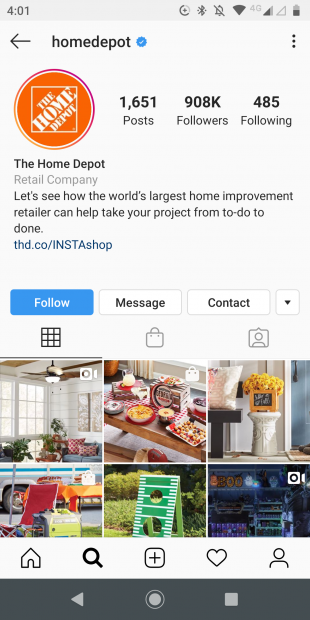
6. Create visually compelling content
Instagram is a visual medium, so your posts have simply got to look great. You don’t need professional photography equipment, but your photos do need to be sharp, well-lit, well-composed, and in focus, at a minimum.
Even more important, your visual content needs to be compelling. Great photos are nice, but if they don’t tell a story, or get viewers excited, they’re not going to help you use Instagram for marketing.
Not sure what to post? Here are a few ideas:
- Behind-the-scenes posts: Give followers a look at your office, your storefront, or your manufacturing process.
- Quotes and text-based images: Play with text to create visually interesting content with no photos required.
- Regrams and UGC: User-generated content is by nature authentic and compelling.
- Instructional posts: Teaching followers how to achieve a goal is about as compelling as it gets.
- Videos: The maximum length of a video post on Instagram is 60 seconds, but you can go much longer with IGTV.
We’ve got a whole blog post packed with content ideas for Instagram, if you need more inspiration.
7. Establish your brand’s “look” on Instagram
Once you decide what type of content to publish, you need to decide how it’s going to look. As we explain in our post on creating an Instagram aesthetic, color influences buying decisions and brand recognition.
Your Instagram look should be consistent across your posts, helping followers easily recognize your content in their feeds.
One great example of this is the Instagram account mr.pokee, home of a hedgehog and a cat dubbed “the world’s cutest adventurers.”

The photos have a consistent color scheme, look, and feel. They’re immediately identifiable.
One easy way to achieve this kind of consistency is to use Lightroom presets. We’ve got a set of five free Instagram presets you can download to get started.
8. Write great captions
True, we just said that Instagram is a visual medium. But that doesn’t mean you can neglect your captions. Your brand voice is just as important as your brand look. Like your visuals, it should be consistent across posts.
Instagram captions can be up to 2,200 characters long, so you can use them for everything from a quick quip to detailed storytelling. That said, only the first two lines of text appear in news feed without tapping more.
Since people tend to scan captions rather than read them thoroughly, you want to get all the important information into those first two lines.
In our post on the best caption length for every social network, we recommend the following Instagram caption lengths:
- Organic posts: 138–150 characters
- Instagram ads: 125 characters
If you’ve got more to say, go ahead and say it. But make sure the extra text is worth it. National Geographic is the classic example of long-form Instagram content. If you can match their level of storytelling, don’t be afraid to go long. https://www.instagram.com/p/B2oUTKPATGh/embed/captioned/?cr=1&v=12&wp=640&rd=https%3A%2F%2Fblog.hootsuite.com&rp=%2Finstagram-marketing%2F#%7B%22ci%22%3A0%2C%22os%22%3A6479%2C%22ls%22%3A6264%2C%22le%22%3A6462%7D
Your caption should be relevant, entertaining or informative, compelling, and on-brand. For more details, check out our post on how to write great Instagram captions.
9. Use hashtags wisely
Hashtags are a key way to increase your visibility and discoverability.
You can use up to 30 hashtags in an Instagram post. But, realistically, you probably don’t want to do that.
We recommend using between five and nine hashtags per post. More than that can look like hashtag stuffing, a spammy tactic that turns followers off. Worse, if you use irrelevant or repetitive hashtags, users can choose not to see your content for that tag.
To get the most benefit, choose hashtags that:
- Are relevant
- Are specific to your niche
- Do not encourage follow- or like-swapping (think #like4like or #followme)
We’ve got a full guide with the latest hashtag strategies for Instagram if you want to do a deep dive on this topic.
10. Engage
If you want engagement on Instagram, you have to engage, too. Posting quality content is great, but if you ignore comments and never interact with any other profiles, you’ll have a lonely existence on the network.
At a minimum, respond to comments users post on your feed. But also seek out popular accounts in your niche, follow them, and like and comment on their posts. Make yourself visible in a non-promotional way.
If someone tags you in a post, check it out and look for opportunities to engage. Can you re-share their post in your feed or in your story?
11. Don’t neglect Instagram Stories
Half of businesses on Instagram use Stories. And they’re getting great results: A third of the most viewed Stories are posted by businesses. Stories are a key part of a good Instagram marketing strategy.
Instagram Stories disappear after just 24 hours. Followers expect them to be more real and raw than your curated Instagram feed. They provide a great opportunity to connect with followers and build relationships.
In our post on the best ways to use Instagram Stories for business, we highlight the following strategies:
- Tell a story: Have a message in mind, even for this in-the-moment format.
- Get interactive: Use Stories features like polls and questions.
- Aim for personal connection: Stories are a huge driver of Instagram direct messages that help build follower loyalty.
- Use a call to action: Don’t rely on the small “swipe up” Instagram overlays for outside links. Use text to tell followers why they should swipe.
- Be consistent: Like your Instagram feed, your Stories should align with your brand voice and aesthetic.
12. Use Stories highlights and covers to boost your bio
We covered all the components of your Instagram bio in Tip 4. But there’s a bonus component we didn’t mention: Stories highlight covers.
You can create highlight albums to preserve your top Stories content, so it doesn’t disappear after 24 hours. Your highlight albums appear right under your bio, and you can create custom covers for each.
Used effectively, this adds a whole extra component to your bio, giving potential followers loads more information about your business and why they should follow you on Instagram.
For example, Rocky Mountain Soap Company uses highlights covers to share some of their core values.
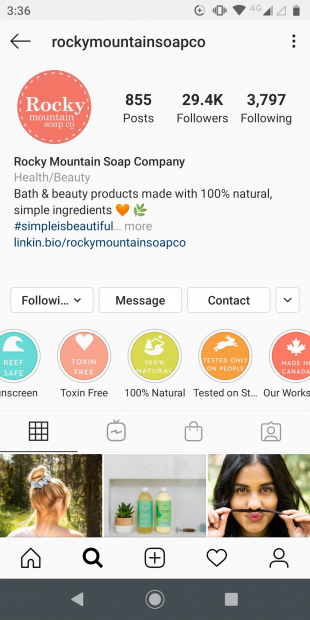
We’ve got 40 free Instagram highlight covers to get you started.
13. Try Instagram Shopping
Remember how we said you should get a business profile? Here’s one more reason why: Access to Instagram Shopping. This feature, which is not available for personal accounts, allows you to sell products directly from Instagram posts and Stories.
Since you can’t link from Instagram posts, this is a huge deal for brands. Here’s an example shoppable post from Clinique.
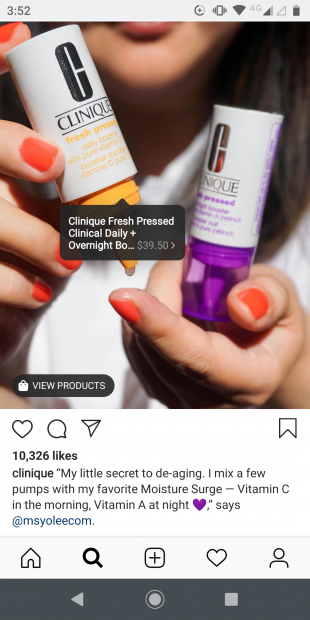
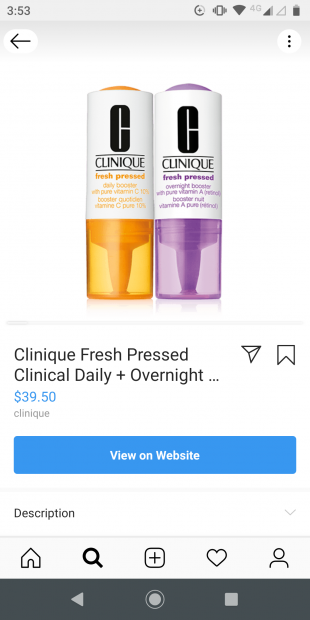
It’s easy to set up shoppable Instagram posts and Stories. Why bother? Simple: 130 million Instagram users tap on shopping posts every month.
14. Post at the right times
Did you know that the best time to post on Instagram varies based on your industry? It’s true.
We analyzed 258,956 posts from 11 different industries and found that there really is a best time to post, even though Instagram feeds are no longer chronological.
Here are the best times to post for each industry we analyzed:
- Travel and tourism: Friday, 9 a.m. to 1 p.m.
- Media and entertainment: Tuesday and Thursday, 12 to 3 p.m.
- Food and beverage: Friday, 12 p.m.
- Retail: Tuesday, Thursday, and Friday, 12 p.m.
- Professional services: Tuesday, Wednesday, and Friday, 9 or 10 a.m.
- Non-profit: Tuesday, 10 a.m. or 4 p.m.
- Non-retail e-commerce: Thursday, 4 or 9 p.m.
- Pharma and healthcare: Wednesday and Sunday, 9 a.m.
- Personal care: Thursday and Friday, 1, 2, or 3 p.m.
- Technology: Monday and Tuesday, 2 p.m.
- Education: Thursday, 4 or 5 p.m.

Get more details, including the worst times to post for each industry, in our blog about when to post on Instagram.
15. Try an influencer partnership
Working with an influencer can help to build your credibility while exposing your brand to a new audience. A survey by CivicScience found that 19% of American consumers have made a purchase because of an influencer or blogger recommendation.
One easy way to get started with influencer marketing on Instagram is to host an Instagram takeover. This means that you invite an influencer to take over your Instagram account for a set period of time, like a weekend, or for a special event.
You can also choose to feature the influencer’s content on your Stories only, as SheerLuxe did with @GinaGoesTo: https://www.instagram.com/p/B2Mk6stDF0J/embed/captioned/?cr=1&v=12&wp=640&rd=https%3A%2F%2Fblog.hootsuite.com&rp=%2Finstagram-marketing%2F#%7B%22ci%22%3A1%2C%22os%22%3A6485%2C%22ls%22%3A6264%2C%22le%22%3A6462%7D

You can preserve the Instagram takeover as a Stories highlight, as SheerLuxe did.
16. Expand your audience with Instagram ads
The surest way to get your content in front of a new audience is to run an Instagram ad. Two million businesses are already using ads on Instagram. And they must be working, because 96% of U.S. marketers already using Stories ads plan to keep doing so.
Back in Tip 3, you defined your target audience. Now you can use that information to target your ads based on:
- Location: State, province, city, country, and so on
- Demographics: Like age, gender, and language
- Interests: Such as other accounts people follow and apps they use
- Behaviors: Both on and off Instagram
You can also upload custom audiences of people you have existing relationships with, and use these to create lookalike audiences.
You can advertise in the Instagram feed, or in Stories.
17. Refine your strategy with analytics
No matter how good you already are at Instagram marketing, you can always be better. The best way to improve your results is to learn from what you’ve already done. And the best way to do that is to study all of the information available in Instagram Insights.


